This set of Linear Integrated Circuit Multiple Choice Questions & Answers (MCQs) focuses on “Differential Amplifier and Circuit Configuration”.
1. A Differential Amplifier should have collector resistor’s value (RC1 & RC2) as
a) 5kΩ, 5kΩ
b) 5Ω, 10kΩ
c) 5Ω, 5kΩ
d) 5kΩ, 10kΩ
View Answer
Explanation: The values of collector current will be equal in differential amplifier (RC1=RC2).
2. A Differential Amplifier amplifies
a) Input signal with higher voltage
b) Input voltage with smaller voltage
c) Sum of the input voltage
d) None of the Mentioned
View Answer
Explanation: The purpose of differential amplifier is to amplify the difference between two signals.
3. The value of emitter resistance in Emitter Biased circuit are RE1=25kΩ & RE2=16kΩ. Find RE
a) 9.756kΩ
b) 41kΩ
c) 9.723kΩ
d) 10kΩ
View Answer
Explanation: In emitter biased circuit, RE1 & RE2 is connected in parallel combination.
⇒ RE = RE1 II RE2 = (RE1× RE2)/(RE1+RE2) = (25kΩ×16kΩ)/(25kΩ+16kΩ) = 9.7561kΩ.
4. If output is measured between two collectors of transistors, then the Differential amplifier with two input signal is said to be configured as
a) Dual Input Balanced Output
b) Dual Input Unbalanced Output
c) Single Input Balanced Output
d) Dual Input Unbalanced Output
View Answer
Explanation: When two input signals are applied to base of transistor, it is said to be Dual Input. When both collectors are at same DC potential with respect to ground, then it is said to be Balance Output.
5. A differential amplifier is capable of amplifying
a) DC input signal only
b) AC input signal only
c) AC & DC input signal
d) None of the Mentioned
View Answer
Explanation: Direct connection between stages removes the lower cut off frequency imposed by coupling capacitor; therefore it can amplify both AC and DC signal.
6. In ideal Differential Amplifier, if same signal is given to both inputs, then output will be
a) Same as input
b) Double the input
c) Not equal to zero
d) Zero
View Answer
Explanation: In ideal amplifier, Output voltage
⇒ Vout = Vin1-Vin2.
7. Find the Single Input Unbalance Output configuration in following circuit diagrams :
a) 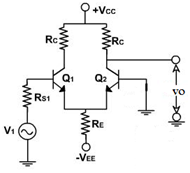
b) 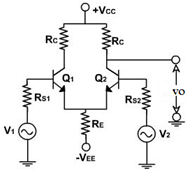
c) 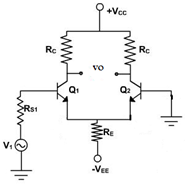
d) 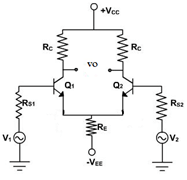
View Answer
Explanation: Circuit c has only single input (V1) and output is measure only at one of the collector with respect to ground.
8. An emitter bias Dual Input Balanced Output differential amplifier has VCC=20v, β=100, VBE=0.7v, RE=1.3kΩ. Find IE
a) 7.42mA
b) 9.8mA
c) 10mA
d) 8.6mA
View Answer
Explanation: Emitter current can be found out by substituting the values in the equation,
⇒ IE = (VEE-VBE)/(2RE) = (20v-07v)/(2×1.3kΩ) = 7.42mA.
9. Find IC, given VCE=0.77v, VCC=10v, VBE=0.37v and RC=2.4kΩ in Dual Input Balanced Output differential amplifier
a) 0.4mA
b) 0.4A
c) 4mA
d) 4A
View Answer
Explanation: Substitute the values in collector to emitter voltage equation,
VCE= VCC+ VBE-RC IC
⇒IC = (VCC-VCE+VBE)/RC = (10v-0.77v+0.37v)/2.4kΩ = 4mA
10. Find the correct match
| Configuration | Voltage gain and Input resistance |
|---|---|
| 1. Single Input Unbalanced Output | i. Ad = Rc/re , Ri1 Ri2 = 2βacRE |
| 2. Dual Input Balanced Output | ii. Ad= Rc/2re , Ri1 Ri2 = 2βacRE |
| 3. Single Input Balanced Output | iii. Ad= Rc/re , Ri = 2βacRE |
| 4. Dual Input Unbalanced Output | iv. Ad = Rc/2re , Ri = 2βacRE |
a) 1-i , 2-iii, 3-iv, 4-ii
b) 1-iv, 2-ii, 3-iii, 4-i
c) 1-ii, 2-iv, 3-i , 4-iii
d) 1-iii, 2-i, 3-ii, 4-iv
View Answer
Explanation: Properties of differential amplifier circuit configuration.
11. Obtain the collector voltage, for collector resistor (RC) =5.6kΩ, IE=1.664mA and VCC=10v for single input unbalanced output differential amplifier
a) 0.987v
b) 0.682v
c) 0.555v
d) None of the mentioned
View Answer
Explanation: Substitute the given values in collector voltage equation,
VC= VCC – RC×IC
⇒ VC= 10v – 5.6kΩ×1.664mA (∵ IC ≅ IE )
⇒ VC= 0.682v.
12. For the circuit shown below, determine the Output voltage (Assume β=5, differential input resistance=12 kΩ)
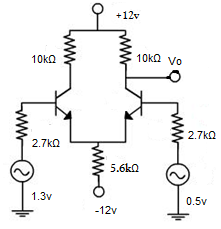
a) 4.33v
b) 2.33v
c) 3.33v
d) 1.33v
View Answer
Explanation: From the circuit dig, RC=10kΩ, Vin1= 1.3v and Vin2=0.5v,
Differential input resistance = 2 βre,
⇒ 12kΩ = 2×5×Re
⇒ Re = 1.2 kΩ
Output voltage Vo = RC/2Re(Vin1-Vin2)
⇒ Vo = 10kΩ/(2 ×1.2kΩ) × (1.3v-0.5v)
⇒ Vo = 3.33v.
13. In a Single Input Balanced Output Differential amplifier, given VCC=15v, RE = 3.9kΩ, VCE=2.4 v and re=250Ω. Determine Voltage gain
a) 26
b) 56
c) 38
d) 61
View Answer
Explanation: In single Input Balance Output amplifier,
⇒ IE = (VEE-VBE)/2RE
=(15v-0.7v)/(2×3.9kom)= 1.83mA (∵VCC=VEE)
From the equation, VCE = VCC +VBE-RC×IC
⇒ RC = (14.3v – 2.4v)/1.83mA = 6.5kΩ
The voltage gain, Vo
⇒ Vo = RC/re
= 6.5kΩ/250Ω = 26(no units).
Sanfoundry Global Education & Learning Series – Linear Integrated Circuits.
To practice all areas of Linear Integrated Circuits, here is complete set of 1000+ Multiple Choice Questions and Answers.
If you find a mistake in question / option / answer, kindly take a screenshot and email to [email protected]
